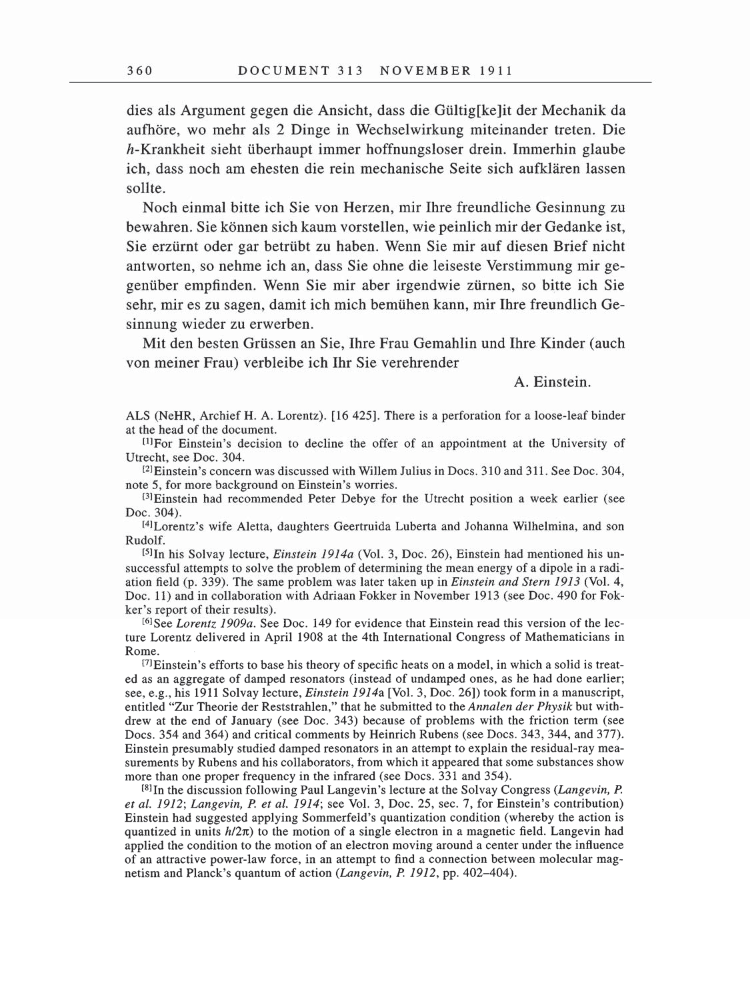360 DOCUMENT 313 NOVEMBER 1911 dies als Argument gegen die Ansicht, dass die Gültig[ke]it der Mechanik da aufhöre, wo mehr als 2 Dinge in Wechselwirkung miteinander treten. Die h-Krankheit sieht überhaupt immer hoffnungsloser drein. Immerhin glaube ich, dass noch am ehesten die rein mechanische Seite sich aufklären lassen sollte. Noch einmal bitte ich Sie von Herzen, mir Ihre freundliche Gesinnung zu bewahren. Sie können sich kaum vorstellen, wie peinlich mir der Gedanke ist, Sie erzürnt oder gar betrübt zu haben. Wenn Sie mir auf diesen Brief nicht antworten, so nehme ich an, dass Sie ohne die leiseste Verstimmung mir ge- genüber empfinden. Wenn Sie mir aber irgendwie zürnen, so bitte ich Sie sehr, mir es zu sagen, damit ich mich bemühen kann, mir Ihre freundlich Ge- sinnung wieder zu erwerben. Mit den besten Grüssen an Sie, Ihre Frau Gemahlin und Ihre Kinder (auch von meiner Frau) verbleibe ich Ihr Sie verehrender A. Einstein. ALS (NeHR, Archief H. A. Lorentz). [16 425]. There is a perforation for a loose-leaf binder at the head of the document. [1]For Einstein's decision to decline the offer of an appointment at the University of Utrecht, see Doc. 304. [2]Einstein's concern was discussed with Willem Julius in Docs. 310 and 311. See Doc. 304, note 5, for more background on Einstein's worries. [3]Einstein had recommended Peter Debye for the Utrecht position a week earlier (see Doc. 304). [4]Lorentz's wife Aletta, daughters Geertruida Luberta and Johanna Wilhelmina, and son Rudolf. [5]In his Solvay lecture, Einstein 1914a (Vol. 3, Doc. 26), Einstein had mentioned his un- successful attempts to solve the problem of determining the mean energy of a dipole in a radi- ation field (p. 339). The same problem was later taken up in Einstein and Stern 1913 (Vol. 4, Doc. 11) and in collaboration with Adriaan Fokker in November 1913 (see Doc. 490 for Fok- ker's report of their results). [6]See Lorentz 1909a. See Doc. 149 for evidence that Einstein read this version of the lec- ture Lorentz delivered in April 1908 at the 4th International Congress of Mathematicians in Rome. [7]Einstein's efforts to base his theory of specific heats on a model, in which a solid is treat- ed as an aggregate of damped resonators (instead of undamped ones, as he had done earlier see, e.g., his 1911 Solvay lecture, Einstein 1914a [Vol. 3, Doc. 26]) took form in a manuscript, entitled "Zur Theorie der Reststrahlen," that he submitted to the Annalen der Physik but with- drew at the end of January (see Doc. 343) because of problems with the friction term (see Docs. 354 and 364) and critical comments by Heinrich Rubens (see Docs. 343, 344, and 377). Einstein presumably studied damped resonators in an attempt to explain the residual-ray mea- surements by Rubens and his collaborators, from which it appeared that some substances show more than one proper frequency in the infrared (see Docs. 331 and 354). [8]In the discussion following Paul Langevin's lecture at the Solvay Congress (Langevin, P. et al. 1912 Langevin, P. et al. 1914 see Vol. 3, Doc. 25, sec. 7, for Einstein's contribution) Einstein had suggested applying Sommerfeld's quantization condition (whereby the action is quantized in units h/2n) to the motion of a single electron in a magnetic field. Langevin had applied the condition to the motion of an electron moving around a center under the influence of an attractive power-law force, in an attempt to find a connection between molecular mag- netism and Planck's quantum of action (Langevin, P. 1912, pp. 402-404).
